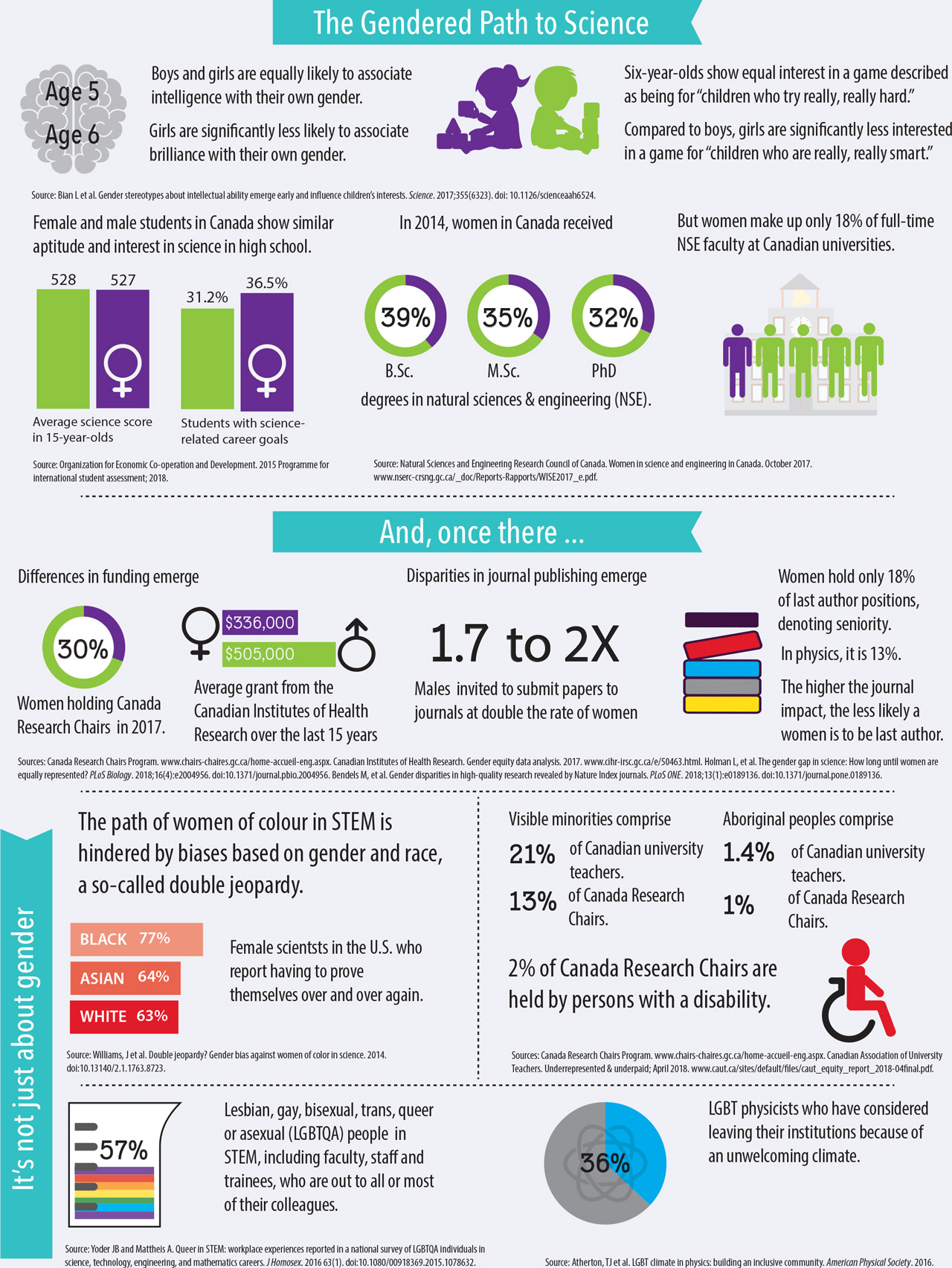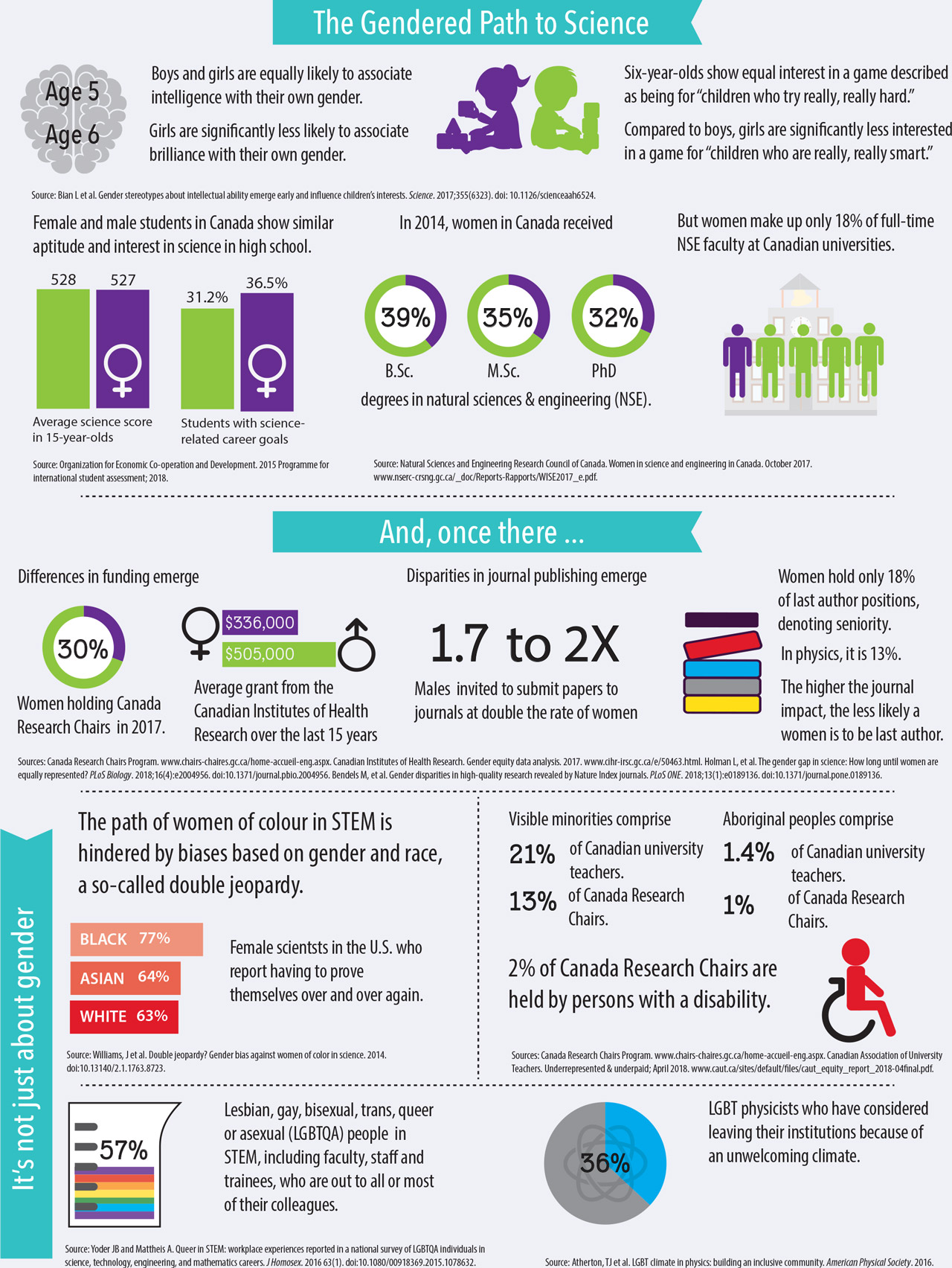Highlighting biases in science and research

Read text-only version of above infographic
The Gendered Path to Science
Age 5: Boys and girls are equally likely to associate intelligence with their own gender.
Age 6: Girls are significantly less likely to associate brilliance with their own gender.
Six-year-olds show equal interest in a game described as being for “children who try really, really hard.”
Compared to boys, girls are significantly less interested in a game for “children who are really, really smart.”
Source: Bian L et al. Gender stereotypes about intellectual ability emerge early and influence children’s interests. Science. 2017;355(6323). doi: 10.1126/scienceaah6524.
Female and male students in Canada show similar aptitude and interest in science in high school.
Average science score in 15-year-olds: males: 528; females: 527
Students with science- related career goals: males: 31.2%; females: 36.5%
Source: Organization for Economic Co-operation and Development. 2015 Programme for international student assessment; 2018.
In 2014, women in Canada received 39% of B.Sc. degrees in natural sciences & engineering (NSE); 35% of M.Sc. degrees in NSE and 32% of PhD degrees in NSE. But women make up only 18% of full-time NSE faculty at Canadian universities.
Source: Natural Sciences and Engineering Research Council of Canada. Women in science and engineering in Canada. October 2017. www.nserc-crsng.gc.ca/_doc/Reports-Rapports/WISE2017_e.pdf.
And, once there …
Differences in funding emerge:
30%: women holding Canada Research Chairs in 2017.
Average grant from the Canadian Institutes of Health Research over the last 15 years: women: $336,000; men: $505,000.
Disparities in journal publishing emerge:
Males invited to submit papers to journals at double the rate of women.
Women hold only 18% of last author positions, denoting seniority. In physics, it is 13%. The higher the journal impact, the less likely a women is to be last author.
Sources: Canada Research Chairs Program. www.chairs-chaires.gc.ca/home-accueil-eng.aspx. Canadian Institutes of Health Research. Gender equity data analysis. 2017. www.cihr-irsc.gc.ca/e/50463.html. Holman L, et al. The gender gap in science: How long until women are equally represented? PLoS Biology. 2018;16(4):e2004956. doi:10.1371/journal.pbio.2004956. Bendels M, et al. Gender disparities in high-quality research revealed by Nature Index journals. PLoS ONE. 2018;13(1):e0189136. doi:10.1371/journal.pone.0189136.
It’s not just about gender
The path of women of colour in STEM is hindered by biases based on gender and race, a so-called double jeopardy.
Female scientsts in the U.S. who report having to prove themselves over and over again:
Black: 77%
Asian: 64%
White: 63%
Source: Williams, J et al. Double jeopardy? Gender bias against women of color in science. 2014. doi:10.13140/2.1.1763.8723.
Visible minorities comprise 21% of Canadian university teachers and 13% of Canada Research Chairs.
Aboriginal peoples comprise 1.4% of Canadian university teachers and 1% of Canada Research Chairs.
2% of Canada Research Chairs are held by persons with a disability.
Sources: Canada Research Chairs Program. www.chairs-chaires.gc.ca/home-accueil-eng.aspx. Canadian Association of University Teachers. Underrepresented & underpaid; April 2018. www.caut.ca/sites/default/files/caut_equity_report_2018-04final.pdf.
57%: Lesbian, gay, bisexual, trans, queer or asexual (LGBTQA) people in STEM, including faculty, staff and trainees, who are out to all or most of their colleagues.
Source: Yoder JB and Mattheis A. Queer in STEM: workplace experiences reported in a national survey of LGBTQA individuals in science, technology, engineering, and mathematics careers. J Homosex. 2016 63(1). doi:10.1080/00918369.2015.1078632.
36%: LGBT physicists who have considered leaving their institutions because of an unwelcoming climate.
Source: Atherton, TJ et al. LGBT climate in physics: building an inclusive community. American Physical Society. 2016.



